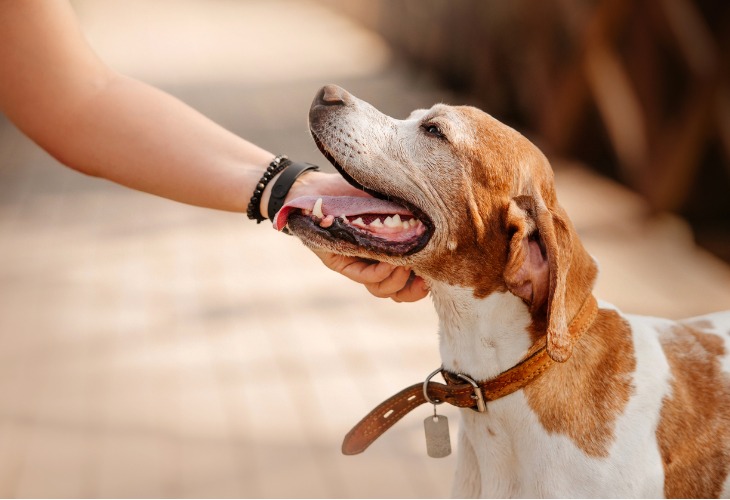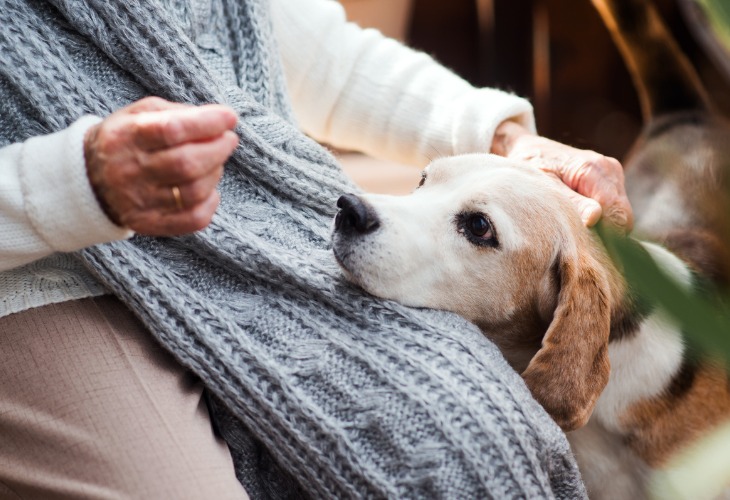Petting your dog is a moment of tenderness for you, but also for your faithful companion. This gesture is synonymous with a moment of sharing and happiness. However, if you don’t know how to do it or if your pet doesn’t consent, petting can be very unpleasant for a dog. In this article, we will show you how to properly pet your dog so that he can enjoy this moment with you.
Make sure that the dog is tactile enough to appreciate being petted

Petting is almost automatic for people who want to please a dog. However, this is not always a good idea. Not all dogs are tactile or appreciate petting in the same way. While some dogs love it, others are more reluctant. Dogs do not see physical contact the same way we do.
When owners systematically pet a non-tactile dog, they may encourage the dog not to approach them when they call. This gesture, although lovingly done, may cause the dog to show signs of aggression. That’s why, before petting a dog, you should make sure that this kind of contact really pleases him.
To do this, take the time to observe his behavior. Give him a hug, then stop and back up to see how he reacts. If he comes back to snuggle, lies on his back, gently pushes your hand, or insists that you continue: this means that he is enjoying the petting. If this is the case, you can stroke him as much as you want.
On the other hand, if he prefers to stay in his corner, he may be less enthusiastic about your caresses. It is better not to insist, so as to avoid frightening him or even irritating him. In this case, it is advisable to first put him at ease by giving him a treat for example. You can also play with him or praise him. You will see that as time goes by, he will be more inclined to accept your caresses. Never forget that a dog needs time to get ready for physical contact.
The fact that a dog is less appreciative of being petted does not make him a dangerous animal. In most cases, this behavior can be a sign of mistreatment that the dog may have suffered in the past. This may have caused him to fear or lose trust in humans. Thus, people who adopt a dog whose history they do not know are often confronted with an animal that avoids physical contact.
Petting a dog: the right approach and gestures

Before petting a dog, unless you know perfectly well that he is fond of cuddling and caressing, the first reflex you must have is of course to check that he is okay with it. To do so, you must reach your hand towards him, palm open, at the level of his nose. If the dog comes towards you and feels your hand, without any signal of avoidance, then he is ready to be pet. On the contrary, if he turns away by turning his head to the side, it is better to avoid any physical contact. In this case, you must try to gain the pet’s confidence.
Once this step is done and the dog has given you the green light, you can proceed with petting. However, you still need to know how you are going to proceed since just like humans, dogs are sensitive and have preferences. In order for him to accept and appreciate your petting, you have to make sure that it is reassuring and comforting. It should not be uncomfortable, intrusive, or rough.
Start by gently stroking him near the throat or under the neck using slow, gentle strokes. Above all, avoid stroking him directly on the head. Being patted on the head is in most cases one of the most annoying gestures of affection for a dog. If the dog is not used to it, it is best to avoid this gesture. Now that your hand is under the dog’s neck, make sure the dog is willing to be petted. There are certain signals that will let you know if the dog appreciates your petting or not:
- Turning his head away,
- Repetitively licking his nose,
- Suddenly stepping back,
- Yawning,
- Curling his lips (revealing his fangs),
- Ears lying back and growling,
- Escaping.
If you misinterpret what the dog wants
If despite the fact that he has indicated that he doesn’t wish to be and you still insist, he may scold you harshly, bite you in the face, or bite you directly to let you know that he wants to be left alone. This is why when a dog shows you that he doesn’t appreciate your petting, it’s best to respect him before the situation gets out of hand.
On the other hand, if he opens his mouth, squints, wags his tail, and sticks out his tongue, it’s because he feels comfortable with you. He feels reassured and shows it to you to invite you to continue. In this case, you can try different types of caresses and discover which one(s) he prefers the most:
- Gentle caresses,
- Kneading,
- Deep or surface stroking,
- Scratching that can end in soft caresses.
Now that he feels secure, identify each area where he likes to be petted. While the back of the neck, head, and back are often a problem, a dog usually enjoys petting, patting, and scratching everywhere else. To please him, you can pet his flanks, chin, chest, and belly.
When should you not pet a dog?

As we mentioned earlier, it is important to avoid petting a dog when it does not want to be petted. On the other hand, your dog’s behavior may show a desire for attention and petting. In fact, petting can be used when training your dog, especially as a reward when he obeys a command. However, you should not pet your dog after bad behavior, because this could encourage him to do it again. Petting should be avoided:
- If you want to calm your dog when he is on a leash,
- If he jumps on you (this could validate the behavior),
- When he is resting in his bed,
- When he is eating.
Also, when a dog is in severe pain or shock (epilepsy, trauma…), you should give up the idea of petting him. This is because he might have trouble differentiating between your good intentions and danger. This would certainly lead him to become brutal and therefore bite you.

